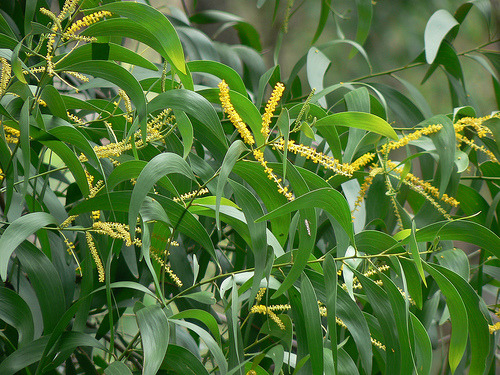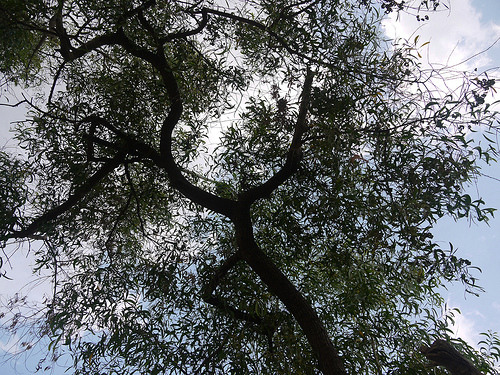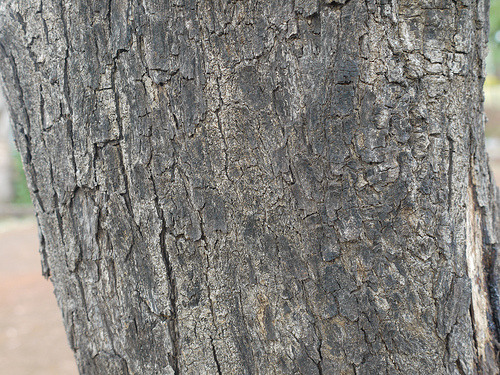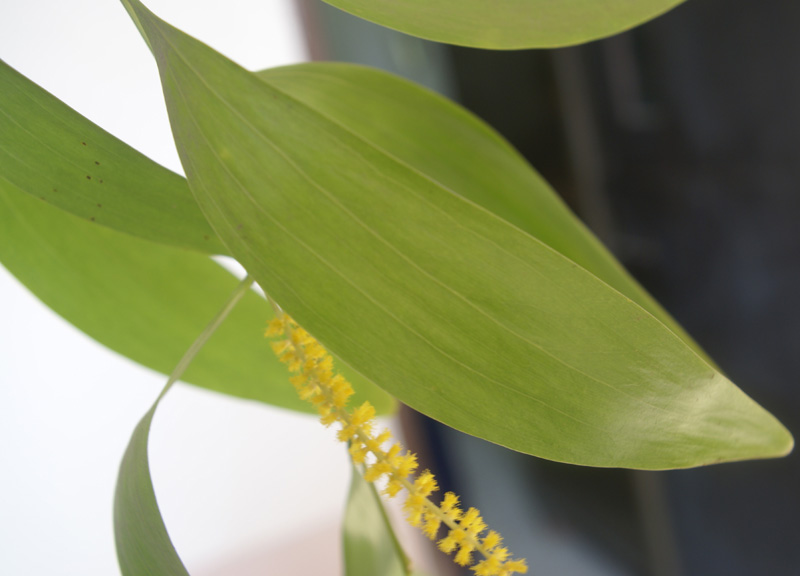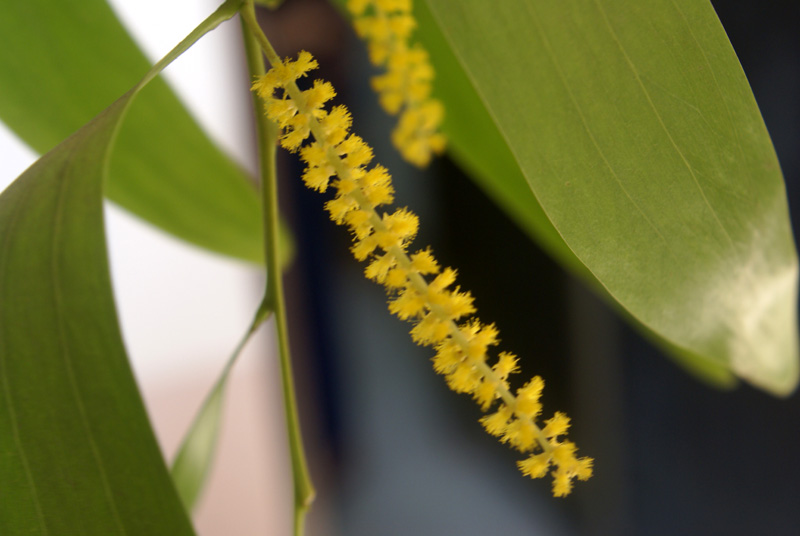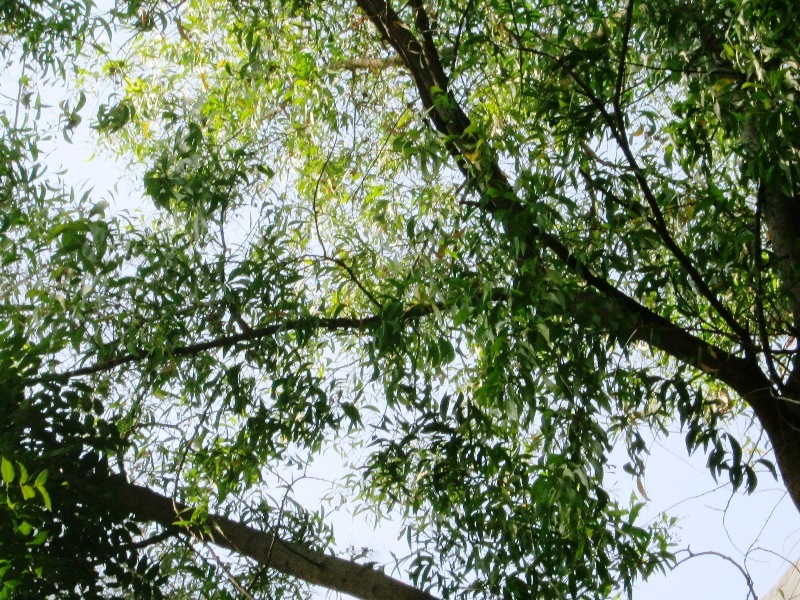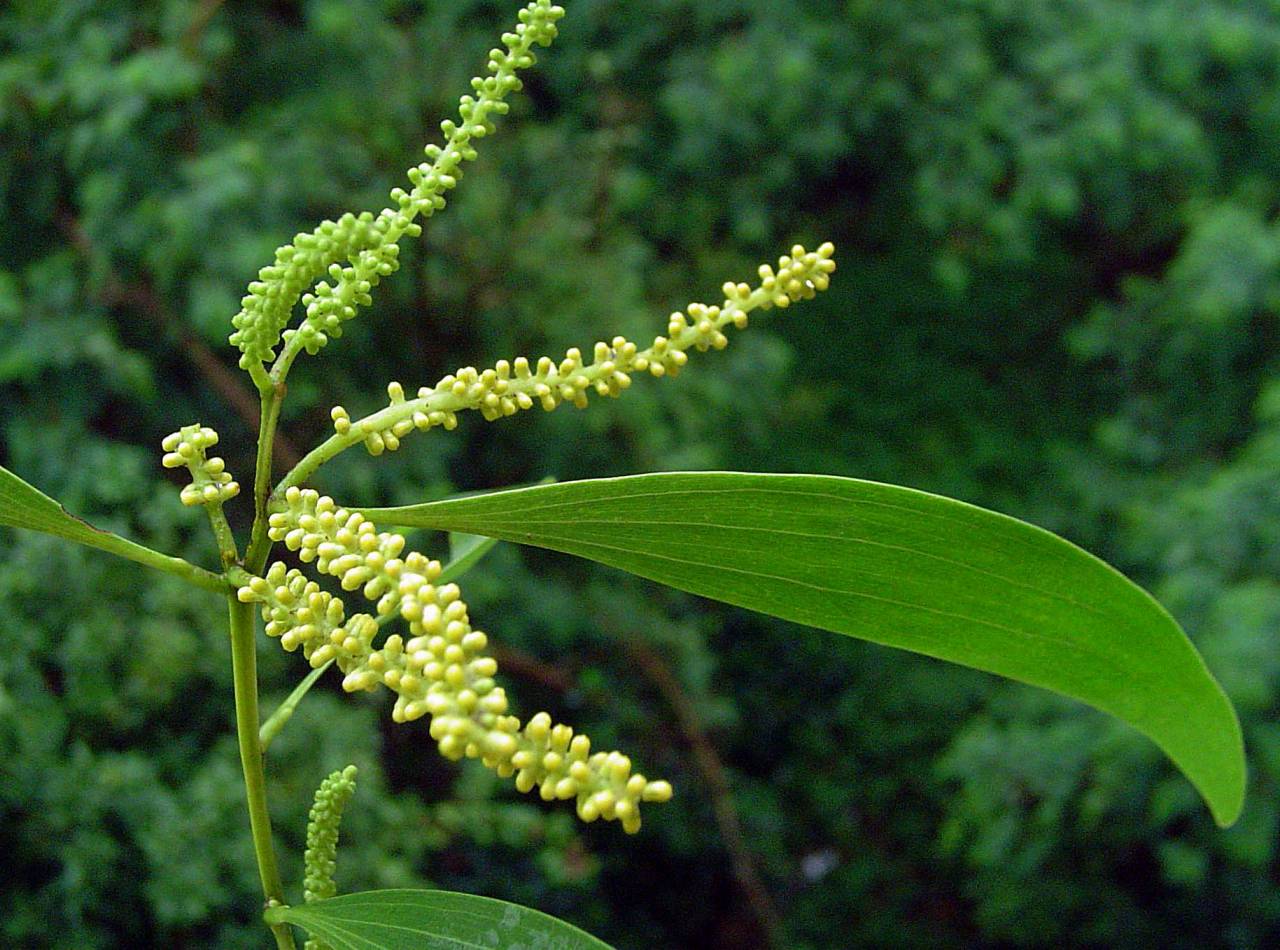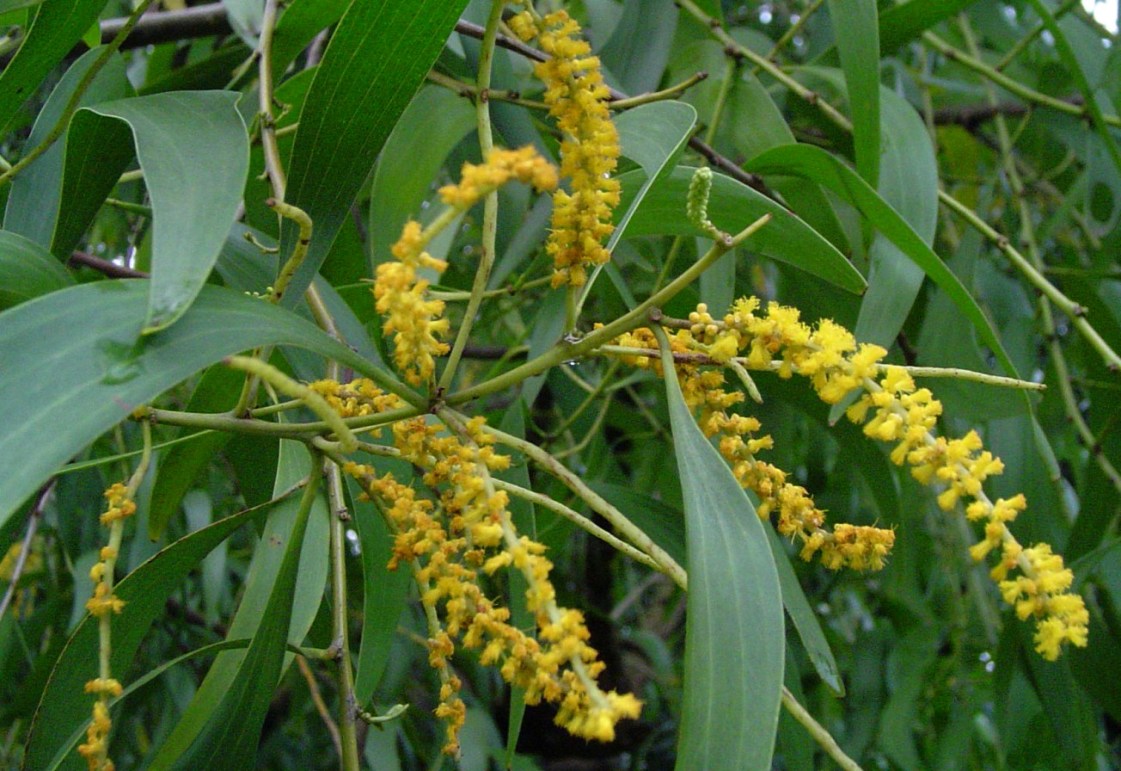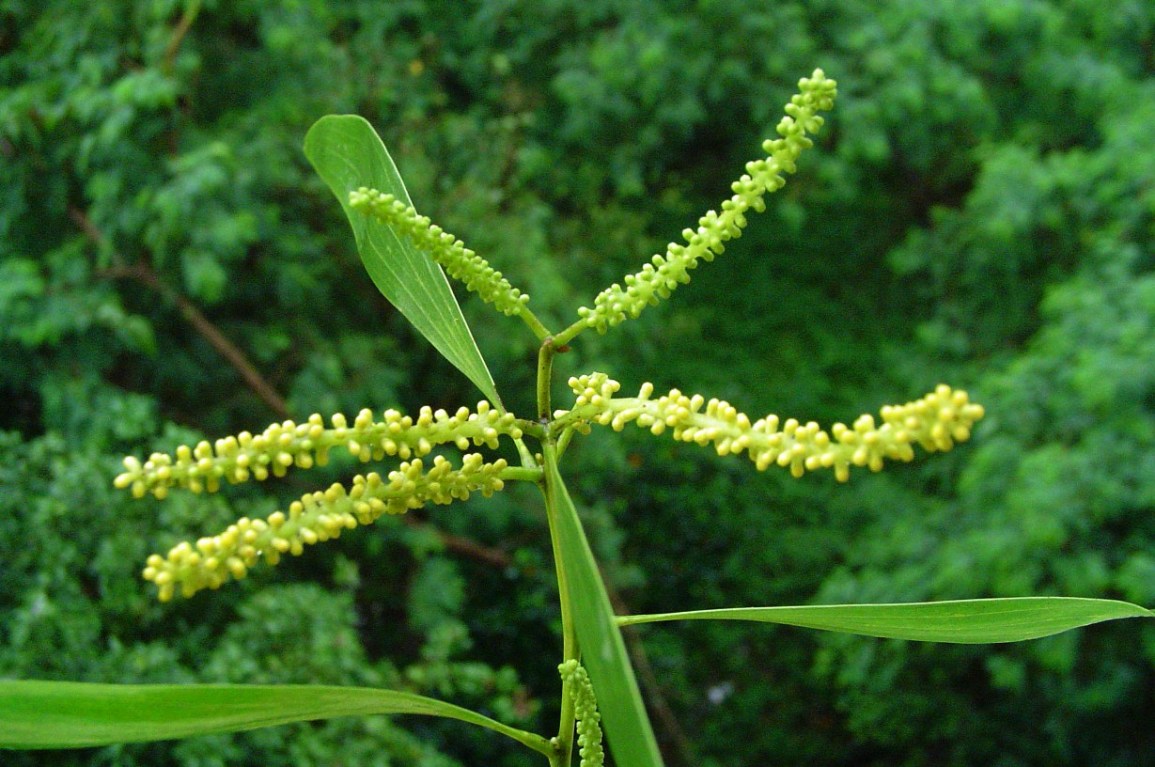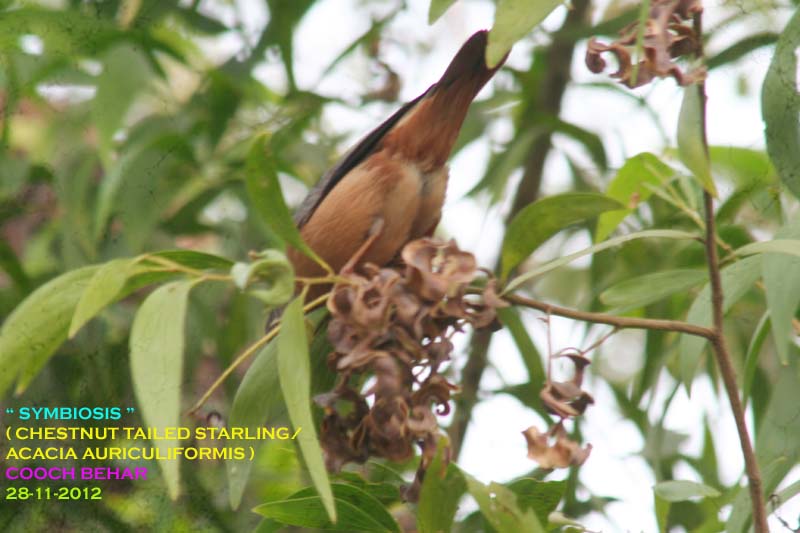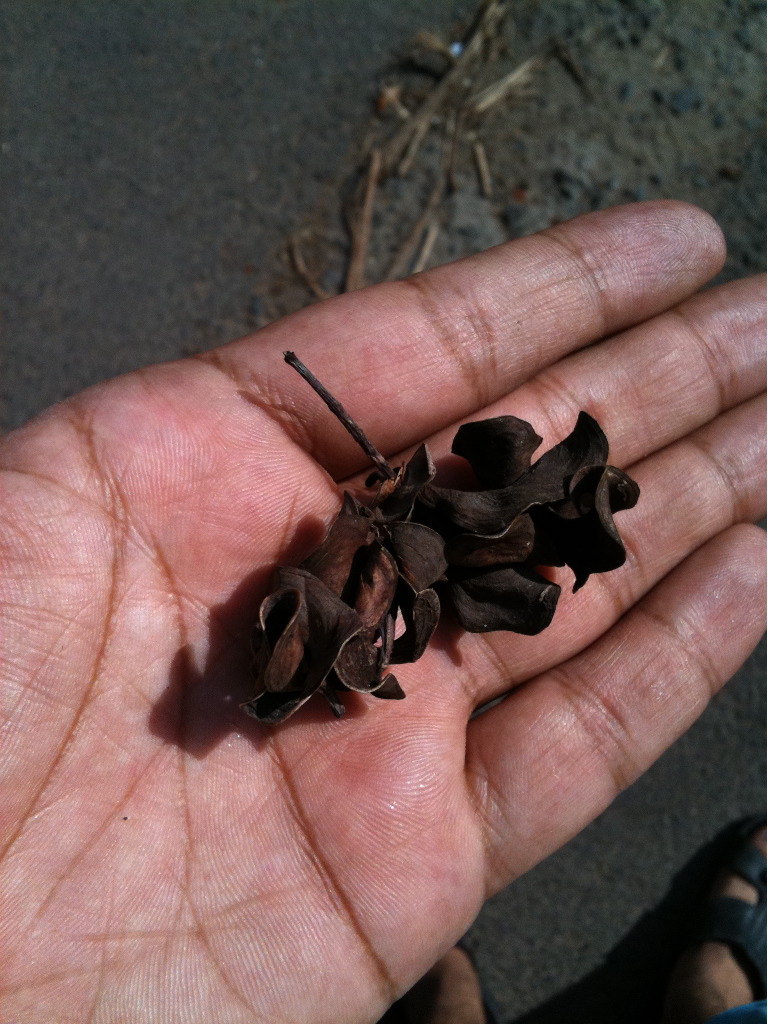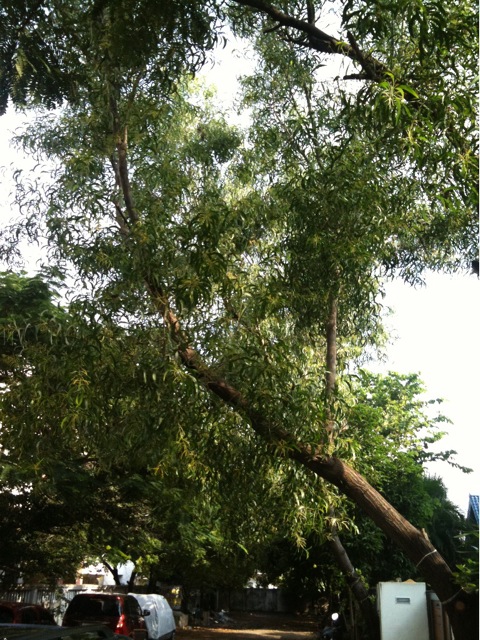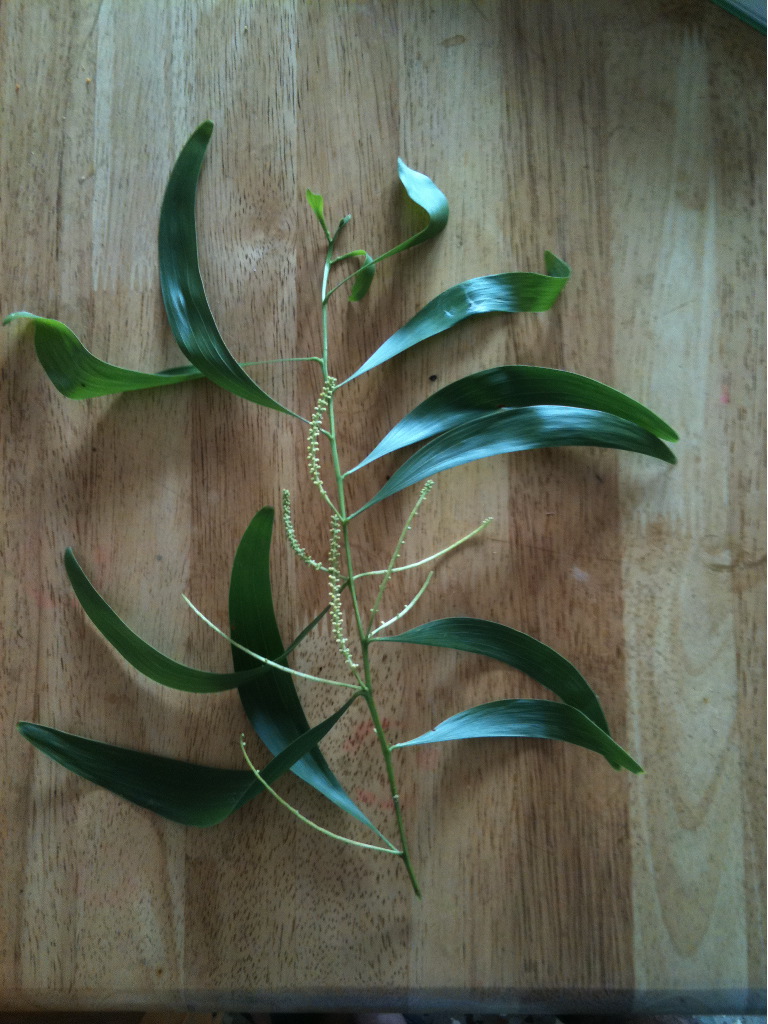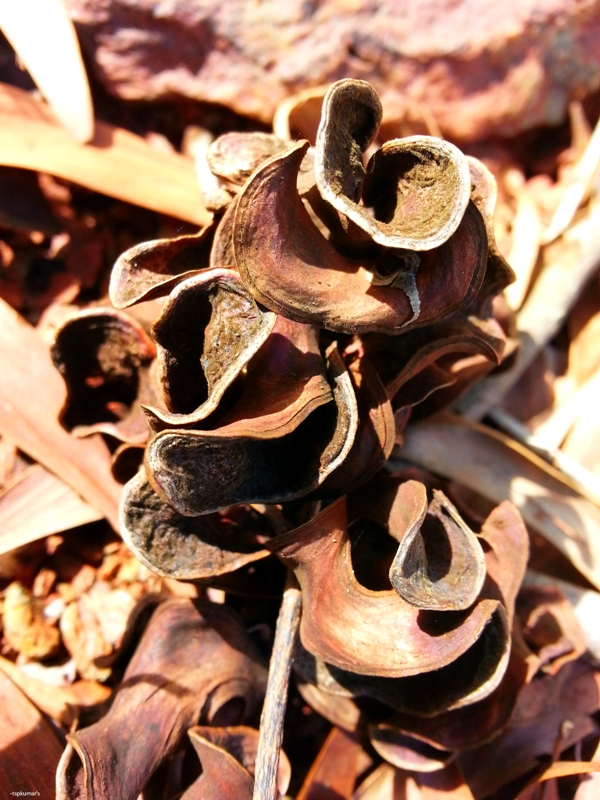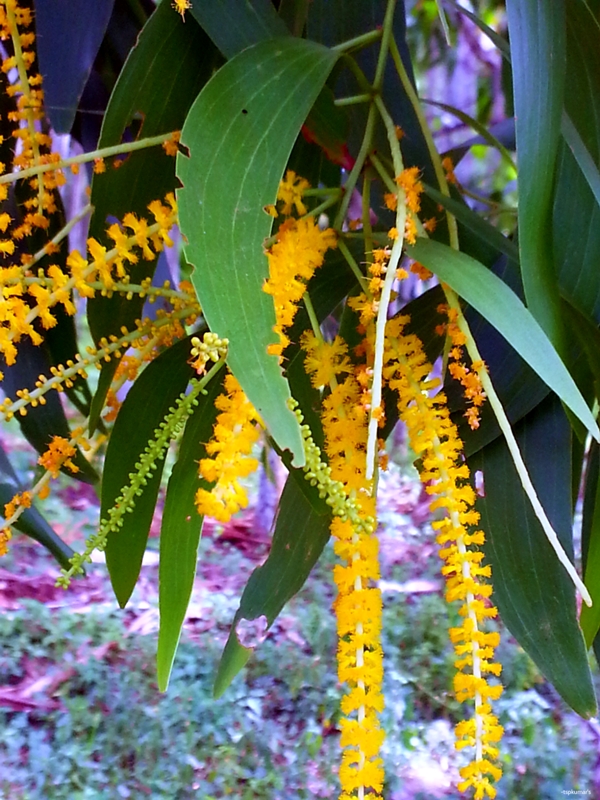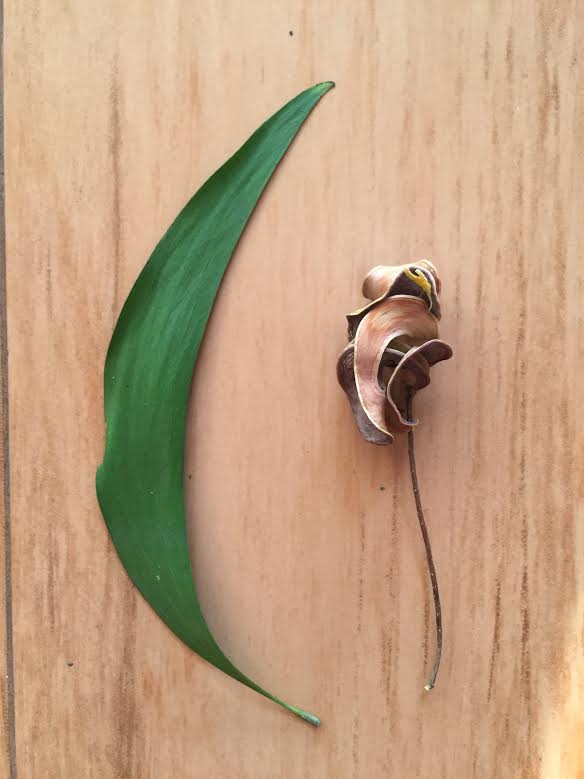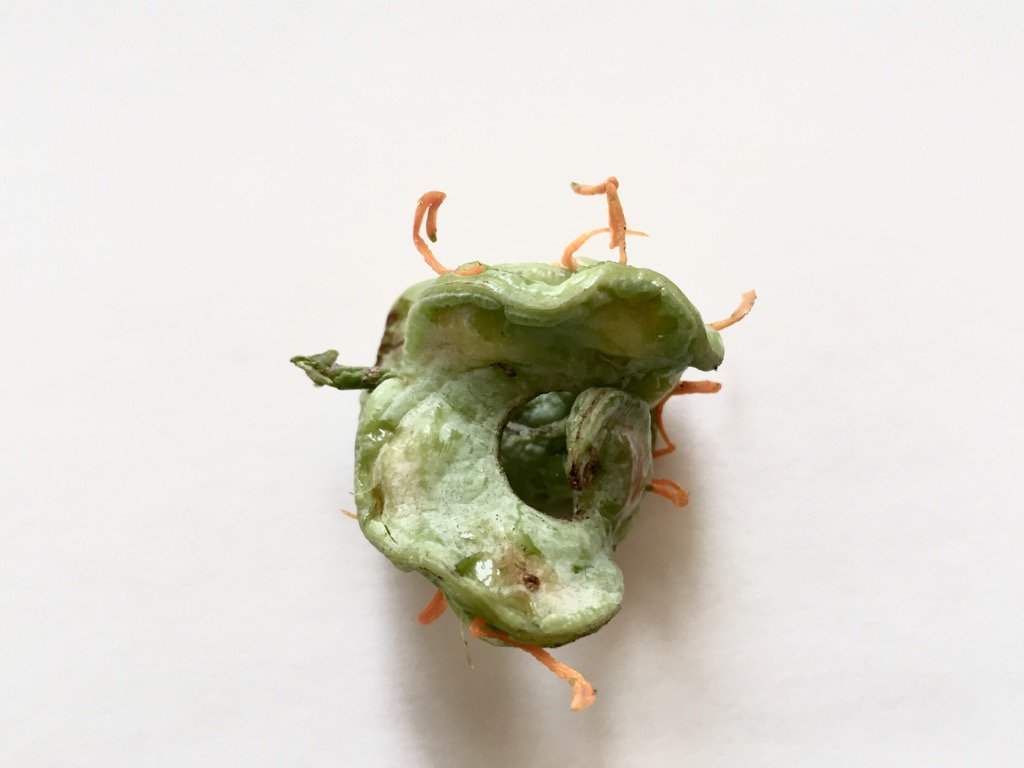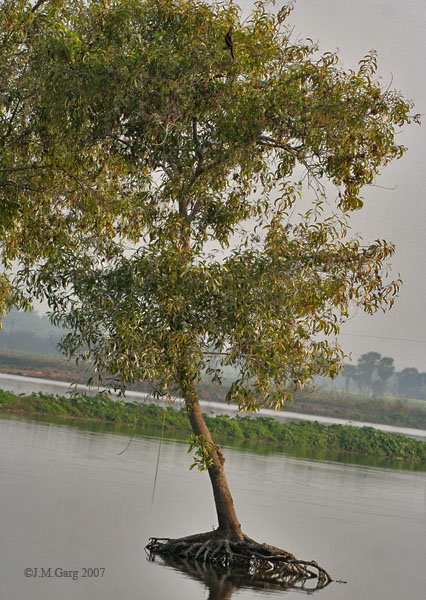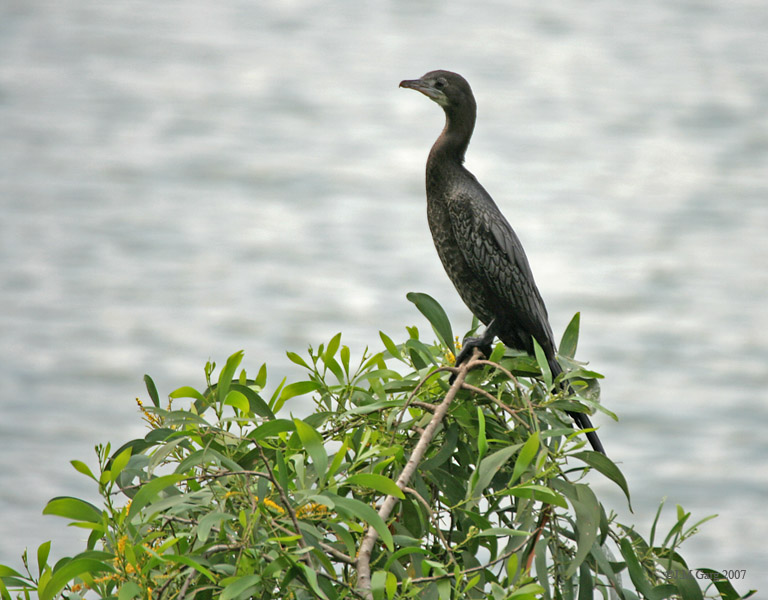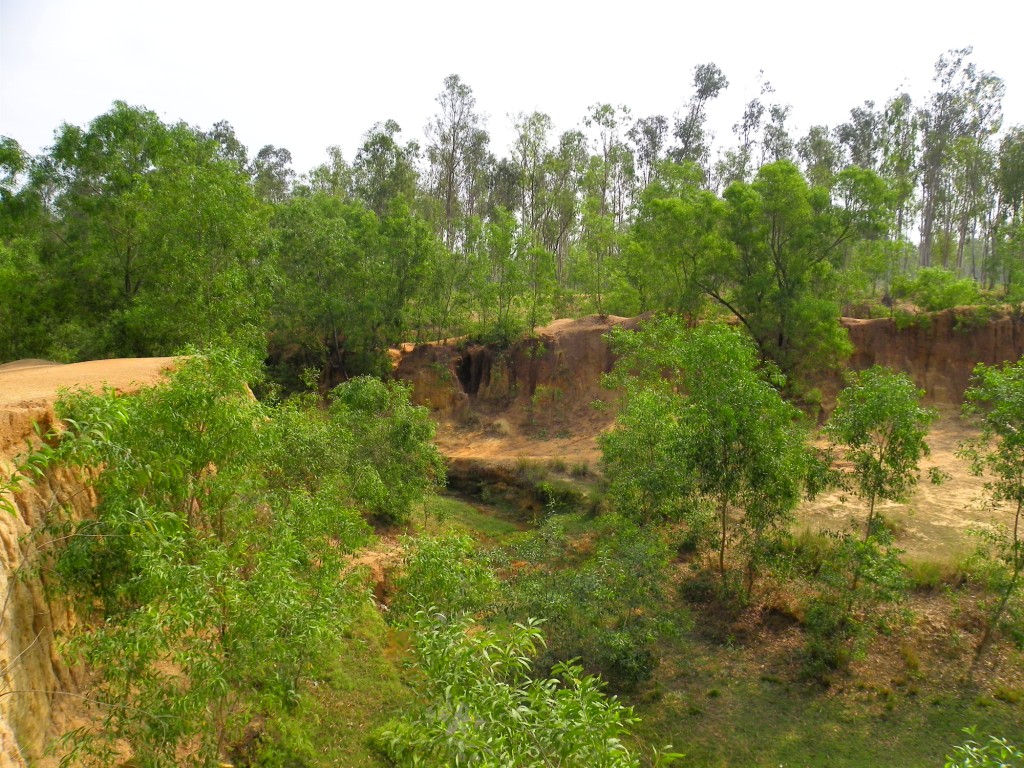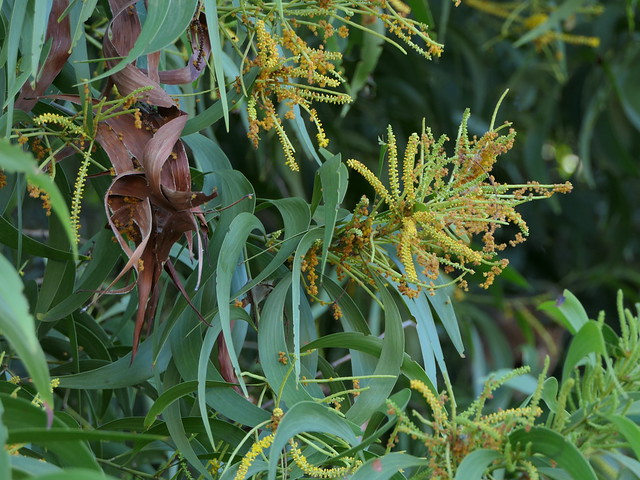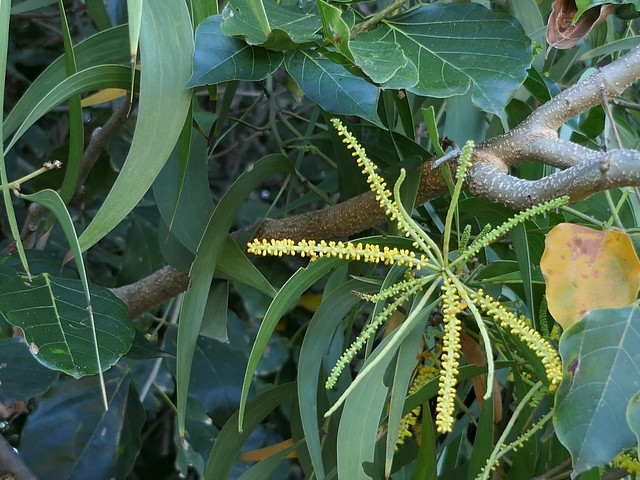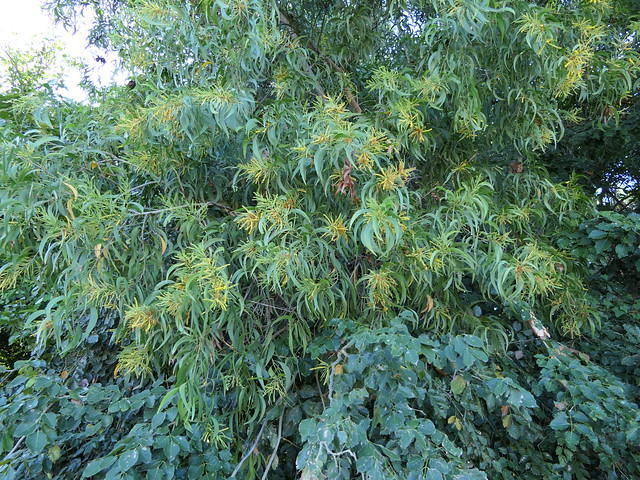|
Acacia auriculiformis Benth. (syn: Acacia auriculaeformis Benth.; Acacia moniliformis Griseb.; Racosperma auriculiforme (Benth.) Pedley);
.
a-KAY-see-uh or uh-KAY-shuh — from the Greek akis, meaning point, barb, thorny, spiny
aw-rik-yoo-lee-for-miss — shaped like an ear, eared .
commonly known as: auri, black wattle, Darwin black wattle, earleaf acacia, earpod wattle, northern black wattle, Papuan wattle, tan wattle, wattle • Bengali: akash mono • Marathi: अकाशिया akashia, ऑस्ट्रेलियन बाभुळ Australian babhool
Native to: Australia, New Guinea; cultivated elsewhere
.
An interesting evergreen tree with leaf petiole modified into leaf-like structure (phyllode); bark smooth, gray-whitephyllode oblong-curved, up to 20 cm long, 2-4 cm broad with 4-6 subparallel main veins; flowers orange-yellow, in axillary or terminal up to 8 cm long spikes; calyx shallowly dentate; petals 2 mm long, oblong; ovary densely puberulent; pod spirally twisted, 5-8 cm long, seeds black, 4-5 mm long.
.
Strange Offspring – A. auriculiformis:
I was surprised by the results of germinating my seeds of Acacia auriculiformis and thought I had mis-labelled the pot. Later I saw and read about the “Phyllodes.” Attaching my pics of the dangling earrings and their progeny. DKB-2 (2011)Acacia auriculiformis: Common Name- Sonajhuri
Family- Fabaceae
Photo taken on- 13.9.2009
At- Kulish smiriti van,jaipur
Description Flowring Good Pic of Australian Kikar Intriguing Leaves of Acacia auriculiformis: This is what we have been teaching our students. Thanks for capturing it at the right stage and showing us. When I was working for a tree plantation project, I had planted millions of this tree. You can see this when the plant grows from the seed. BUT I am still ignorant of the tree’s ID and Wish you a happy Hindu New Year. Thank you very much for your curiosities, hope I satisfy them at least partially.
This is my first attempt to handle the new format yet I believe that my post carries the name Acacia auriculiformis. Ironically the post itself became more intriguing than the leaves. Earleaf Acacia and Australian Acacia are more names to help you navigate with Google. Pardon me for defficient and confusing information. I am attaching another image to help you ID this invasive tree that has reached most of our wild habitats.
I am also a pitiable non botanist like most of us. Please excuse me to have narrated in a style that disguises me to be a card carrying botanist. I take privilege of passing the batton of your queries to a person who carries the necessary stars and shoulder pips. There is a famous doctrine in Biology which all of us are familiar with “Ontogeny Repeats Phyllogeny“. The modified leaf of Australian Acacia (Acacia auriculiformis) is derived from the normal bipinnate leaves so common in other Acacia species. In this evolutionary modification the pinnae got reduced and their function was taken up by the flattened petiole (called Phyllode, as against phylloclade of Opuntia which is a modified stem taking function of leaf) of the leaf in the adult plant. Hence it is common to see juvenile plants with some pinnae at the tip of the phyllode, and these eventually fall off. Adult trees are without these pinnae and have only flattened phyllodes functioning as leaves. Of course every leaf has to fall once it has become old: In evergreen trees they develop and fall off periodically so that tree remains green throughout the year (Mango, Alstonia, etc.); In deciduous trees on the other hand the fresh leaves appear in spring (Late February-March-early April) and all fall off in autumn so that tree remains naked for few months in winter (Prunus, Pyrus, Salix, Populus).
Delhi (and perhaps some other warmer cities in India) don’t have typical four seasons. Here so called autumn is brief few days in March when deciduous trees suddenly lose their leaves and fresh leaves come up after a gap of few days, the Delhi Spring.
I hope I have shared some helpful information. I found a univ of queensland teaching manual … in it they describe exactly the two leaf types you just talked of… I am sending the url in for sake of sharing with other non-botanists like me and for sake of completion for archives… It is at : http://www.uq.edu.au/_School_Science_Lessons/9.70.1.GIF efloraindia: 071111 BRS136 Fabaceae- week: Pl. find the attached file contain photos of Acacia auriculiformis.
Location: NBNP Garden, Anaikatti
Habitat: Garden
Habit: Tree Adding my pictures taken in Hyderabad (Red soil).
SYMBIOSIS 62: Is it Acacia auriculiformis commonly seen in Kolkata ? You are right sir. It is Acacia auriculifirmis indeed. Flora of Haryana: Acacia auriculiformis Benth. from CCS Haryana Agricultural University Hisar: I hate this tree in general because it is not native to India and grows rampantly here. (Personal views) though the flowers and fruits and even the so called leaves look really beautiful. I have some pictures of the fruits. Will search and probably post during the family week which is just round the corner…. Yes … not good being non native. Here in Haryana found Occasionally only and mainly planted not wild is this what is called gando baval in gujarat? I dont know Gujrati name. I think this is natural in dry regions of Haryana Fabaceae – Mimosoideae – Bangalore – RA – Acacia auriculiformis – Earpod Wattle Tree: It’s roots are very strong and can break through concrete, ruining sidewalks and driveways and pushing out other vegetation.
Used for the cultivation of the lac insect in India.
This plant is native to southeast Asia, Indonesia, Papua New Guinia and Australia
Fabaceae-Mimosoideae (Mimosaceae) Week: Acacia auriculiformis -Flora of Rajgadh: Fabaceae – Mimosoideae- week. Acacia auriculiformis: I marvel at what the mother nature will do to ensure seeds dispersal, ??? just to attract the eye of the seed eater!!!
Yellow or red in some cases…. Mimosoideae week (Mimosaceae): Acacia auriculaeformis_RKC06_02012012: Just now learnt the accepted name……A. auriculiformis Benth. is this one more of those Phyllodes form of leaf?
This is a detailed shot indeed …. Nice capture
Waooooooooooooooooo. Superb background and superb focus.
a-KAY-see-uh or uh-KAY-shuh — from the Greek akis, meaning point, barb, thorny, spiny
aw-rik-yoo-lee-for-miss — shaped like an ear, eared Jun 21, 2007 … planted in Yeoor Hills, Sanjay Gandhi National Park, Maharashtra
commomly known as: auri, black wattle, Darwin black wattle, earleaf acacia, earpod wattle, northern black wattle, Papuan wattle, tan wattle, wattle • Bengali: akash mono • Marathi: अकाशिया akashia, ऑस्ट्रेलियन बाभुळ Australian babhool Native to: Australia, New Guinea; cultivated elsewhere more views: Jun 21, 2007 … planted in Yeoor Hills, Sanjay Gandhi National Park, Maharashtra Jul 7, 2007 … at Dr Babasaheb Ambedkar Udyan, Powai, Mumbai
Dec 20, 2009 … at a hotel resort in Jawahar, Maharashtra Yes, one more complete set of photographs.
syn: Racosperma auriculiforme (A. Cunn. ex Benth.) Pedley
Common names: black wattle, Darwin black wattle, ear-leaf acacia, ear-pod wattle, northern black wattle
An interesting evergreen tree with leaf petiole modified into leaf-like structure (phyllode); bark smooth, gray-whitephyllode oblong-curved, up to 20 cm long, 2-4 cm broad with 4-6 subparallel main veins; flowers orange-yellow, in axillary or terminal up to 8 cm long spikes; calyx shallowly dentate; petals 2 mm long, oblong; ovary densely puberulent; pod spirally twisted, 5-8 cm long, seeds black, 4-5 mm long.
Photographed from Vikas Puri, New Delhi, flowering in October-November, pods maturing in April-May
? Acacia auriculiformis Kindly validate
at a private society at Pune
about 80-100 feet tall tree full of reddish curved pods
striped bark
curved leaves
no flowers were seen
interesting looking curved pods had fallen down with glistening black seeds attached with yellow orange string like structure. Yes, I think your id is correct. Yes … your ID is correct.
Sharing few photographs of Acacia auriculiformis. Acacia auriculiformis : Lalbagh,Bangalore : 091012 : AK-3: SYMBIOSIS : 277: Need I’d help: Acacia auriculiformis (family: Fabaceae) commonly known as earleaf acacia,
native to: Australia, New Guinea; cultivated elsewhere. Acacia auriculiformis. The pollens are allergic causing lung related problems. SYMBIOSIS : 346 : Attachments (1). 1 post by 1 author.
Yes … It is Acacia auriculiformis.
It is my pleasure to share few images of Acacia auriculiformis (Fabaceae)
Habit: Medium tree
Habitat: Cultivated.
Sighting: Chikmagalur and Hassan, Karnataka about 1000 msl.
Date: 23-06-2014, 26-06-2014, 05-12-2014 and 18-07-2015 Have a look at the attached photo – as to how they decorate themselves with the flowers. very colourful. Thanks for showing it. so boys decorate themselves too, it seems. the yellow at least one of the long hanging inflorescence is this acacia i think is it? what is the red and the round mala of yellow flowers that he has on? Thanks. I have many more to share which I will do when opportunity comes.
One slight correction – she is a young girl, wearing garland of the inflorescences of Acacia auriculiformis. Most of them wear red bands as they adore red colour. Here these bands are not of flowers but the ones available in market, gifted to her by some visitor. sorry i thought her to be different. facial features somewhat prompted me to think it might be a male child. — the red mala did seem to be “tightly” strung in flowers, could not identify them Pure red flowers are few in the forest. They use red ochre on face prepared from soil and some algae. Tourism continues but with restrictions. Vehicles are allowed to ply through the reserve along the Trunk road in groups and you can not stop the vehicle on the way. Otherwise entry into the reserve is prohibited. But poachers are there, for felling of trees, fishing, hunting and sand mining. Forest dept. and police are not having enough strength and manpower to stop all these. However, the Jarawas are coming out frequently to human settlements and enjoying bus ride on the roof of the bus and going to villages for collecting banana and other fruits. Govt. providing them red bands, threads, medical aid and whatever else they require. I have been going nuts trying to identify this tree. Attached please find image of fruit and leaf.
Can you help me?
Most likely Acacia auriculiformis as per images herein The leaf remind of phyllode of Acacia. Acacia auriculiformis to me too. Seems right: http://indiabiodiversity.org/species/show/228564 Location: New Town Eco Park
Kolkata, India
Date: 10 September 2017
Elevation : 25 ft.
Acacia auriculiformis. Yes, …
Is this Earpod Wattle (Acacia auriculiformis) (150509SCS(7-10) – indiantreepix | Google Groups Acacia auriculiformis :: Puducherry :: 13 OCT 19 : 4 posts by 3 authors. 5 images.
Puducherry near sea coast Date: October 13, 2019 … Altitude range: about 0 – 3 m (0 – 10 feet) asl
Acacia auriculiformis Benth.
.
Fabaceae: Acacia auriculiformis: 4 high res. images.
Acacia auriculiformis from Andhra University Botanical Garden Visakhapatnam Andhra Pradesh on 02/02/2024 / References:
|
Disclaimer
1. For any mistake in identification or for becoming efloraofindia e-group member (for contributing towards building of efloraofindia or otherwise), pl. mail to indiantreepix@googlegroups.com or itpmods@googlegroups.com
2. For better viewing of species’ pages, colour scheme & formatting is being followed as: Description of the species, Details of other flora species on the same page, Uses/ harms, Distribution, Abundance/ Location/ Flowering time & date, Habit & habitat, Etymology & pronunciation, Other interesting information, stories etc., Others, Botanical names, Common names, Main point of discussion below, Discussion about Botanical names.
Navigation
- Award for eFloraofIndia
- Colour scheme & formatting
- Copyrights, Permissions, Citations
- eFloraofIndia appreciated
- Names of Plants in India site
- Flowersofindia site
- Posting Guidelines
- For members’ information
- Logo, Tagline, Acronym
- Volunteers required
- ‘Pitamah’ of eFloraofIndia
- ‘अजेय’ ‘Ajey’ of eFloraofIndia
- ‘Saarthi’ ‘सारथि’ of eFloraofIndia
- ‘Jewel’ of eFloraofIndia
- ‘Grassman’ of eFloraofIndia


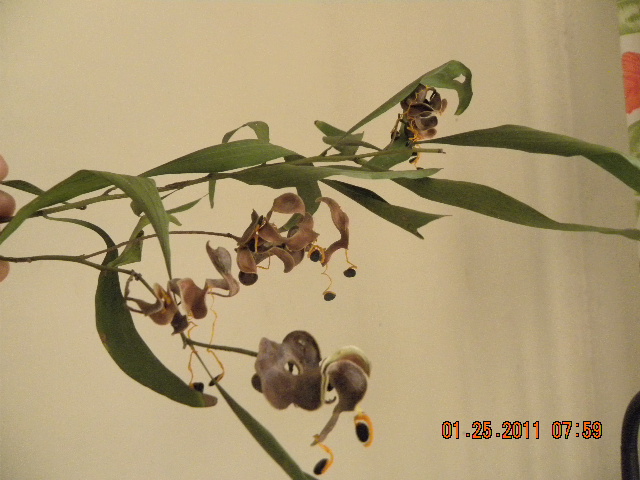
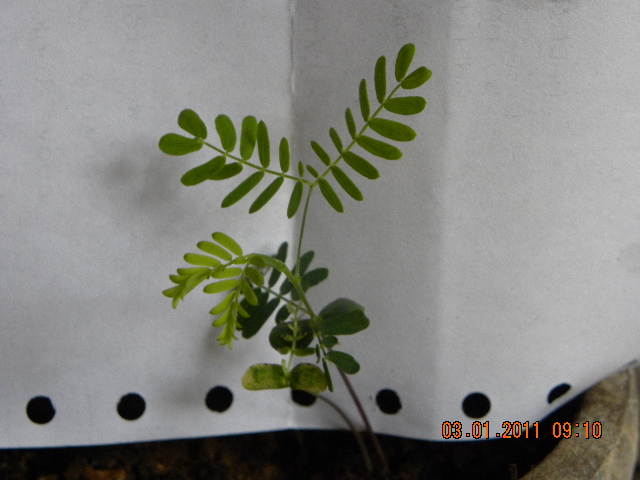
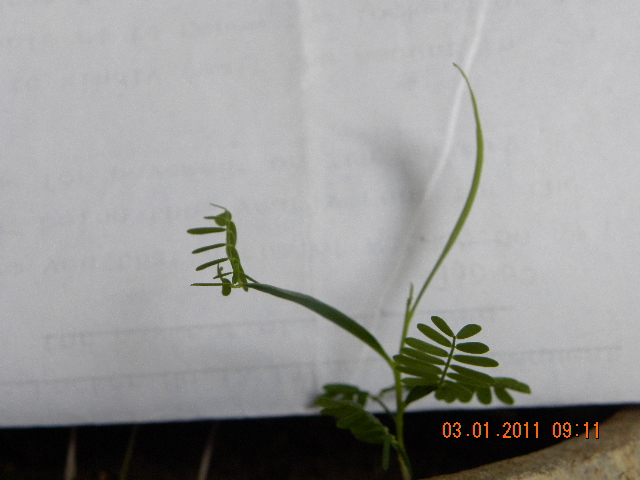

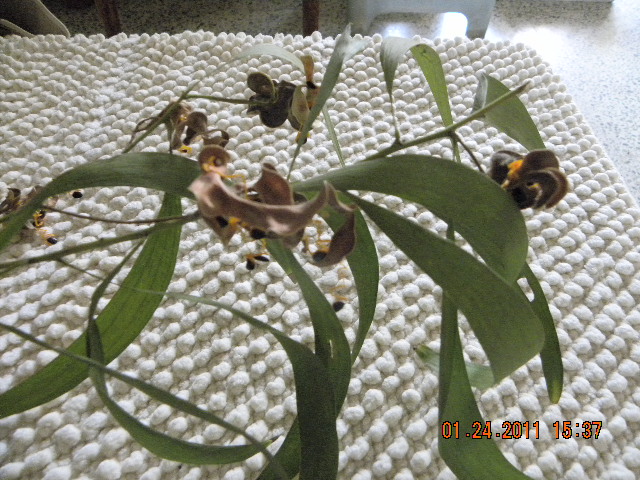

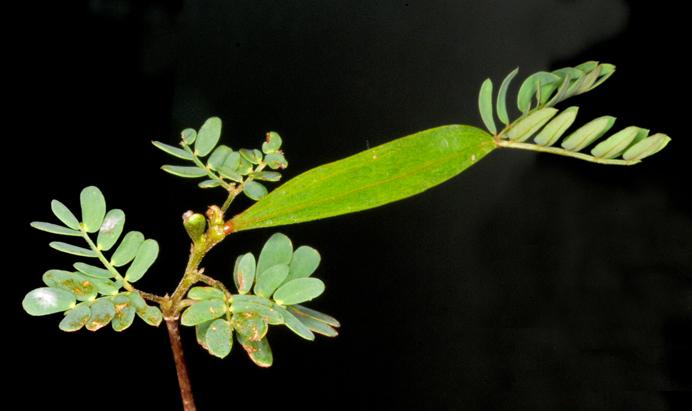
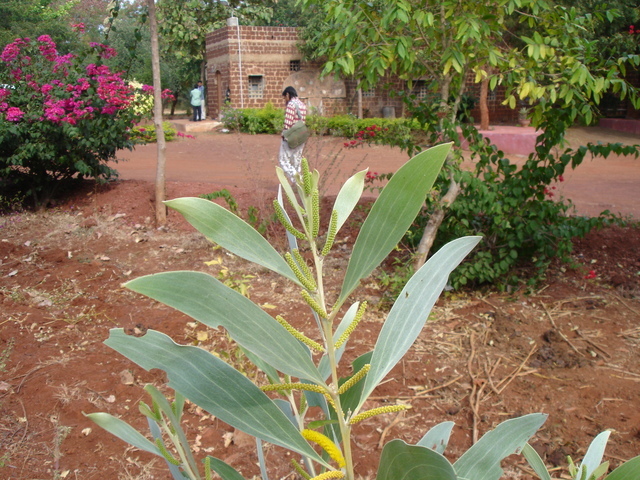
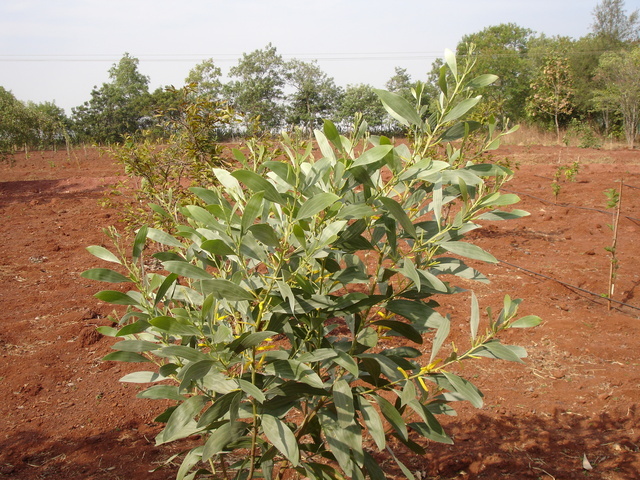


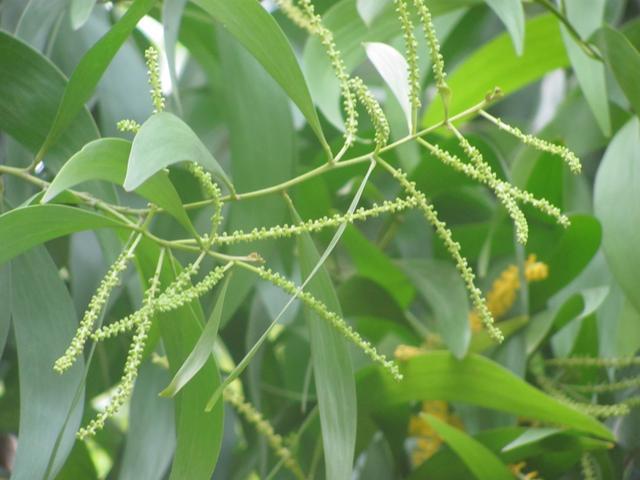
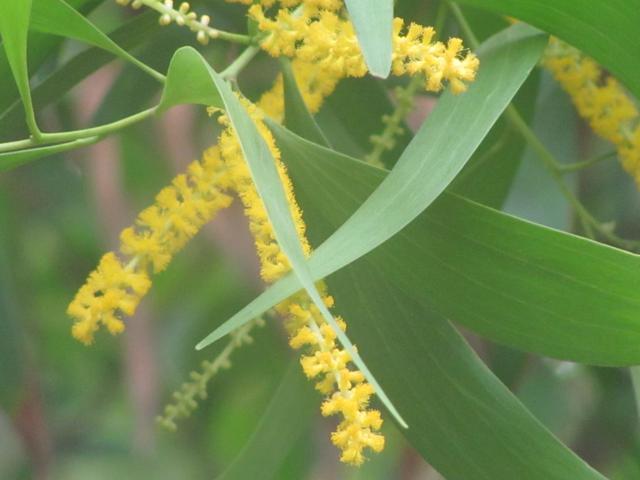
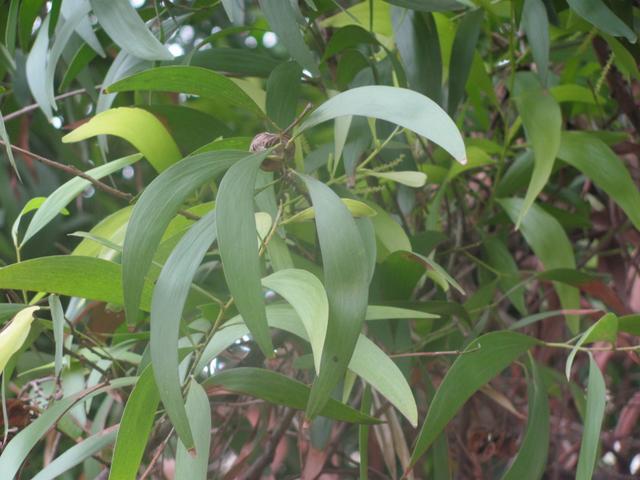

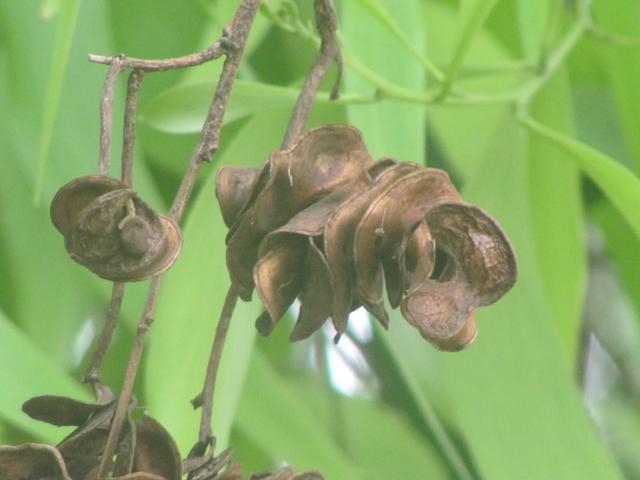

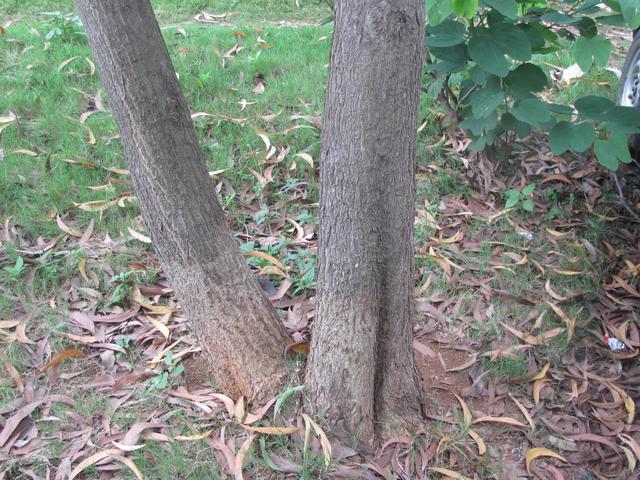
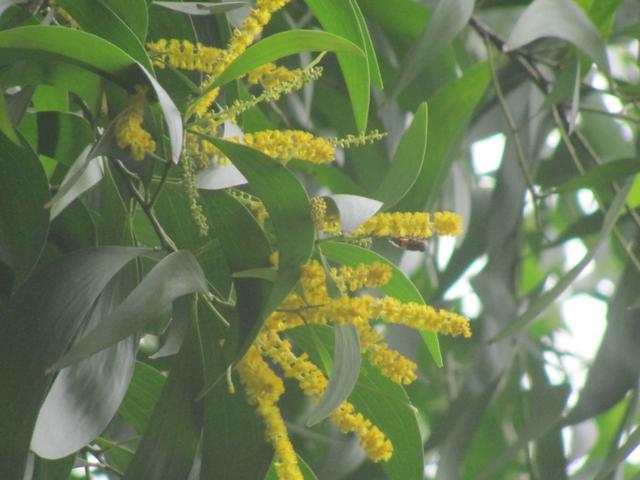




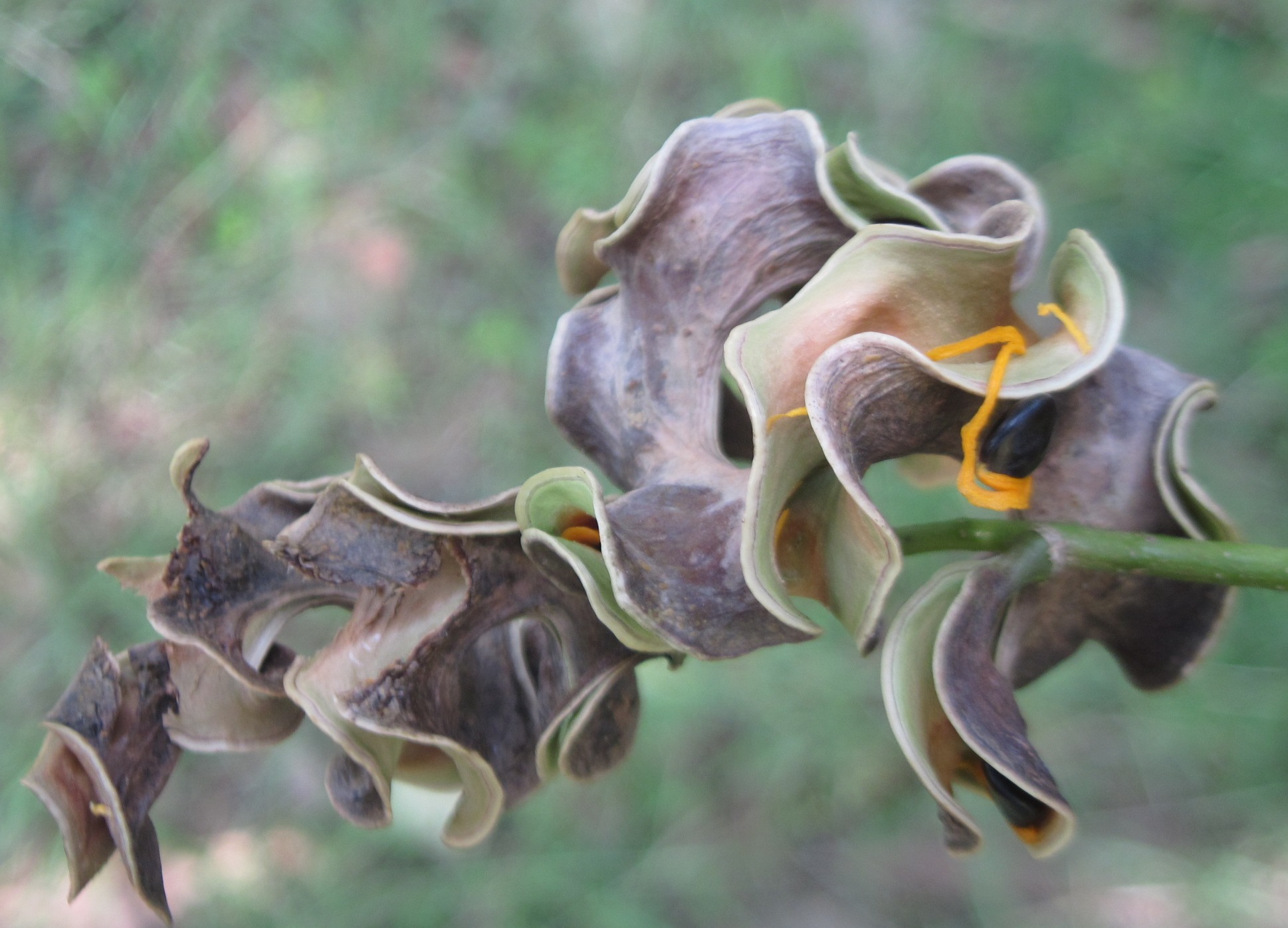
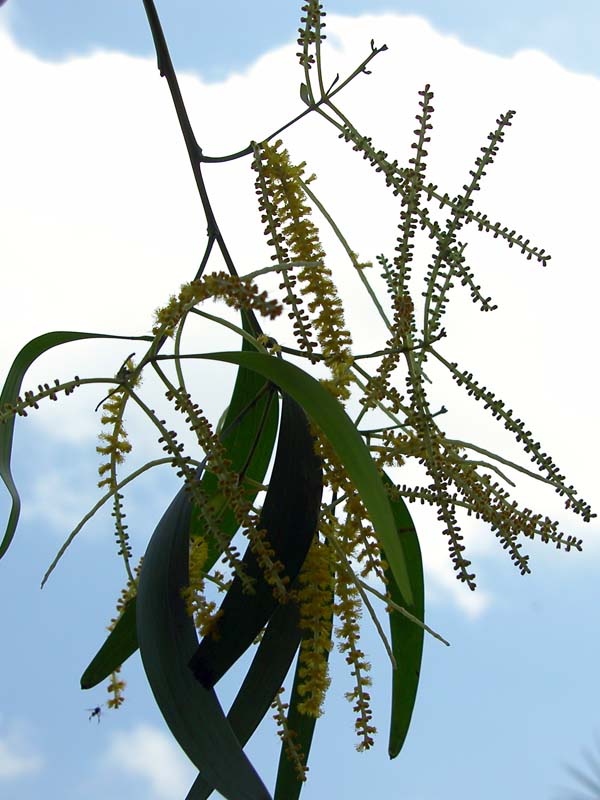
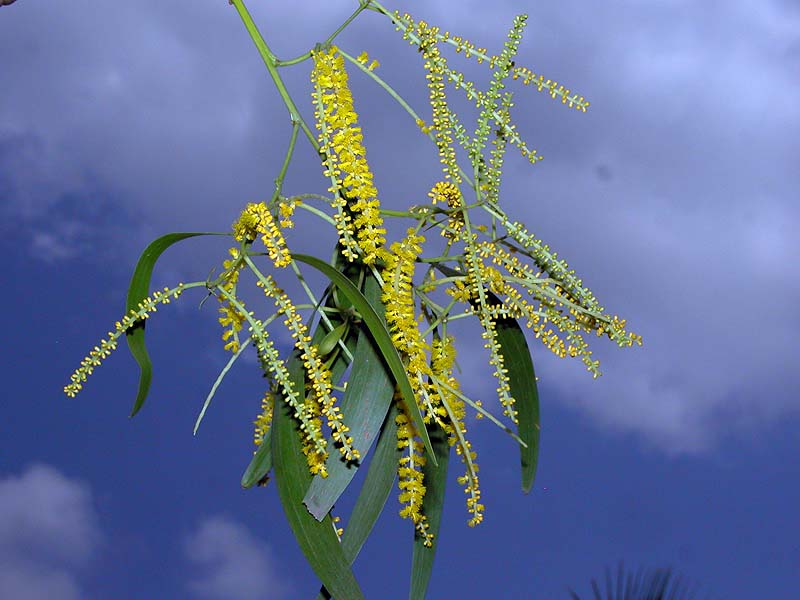
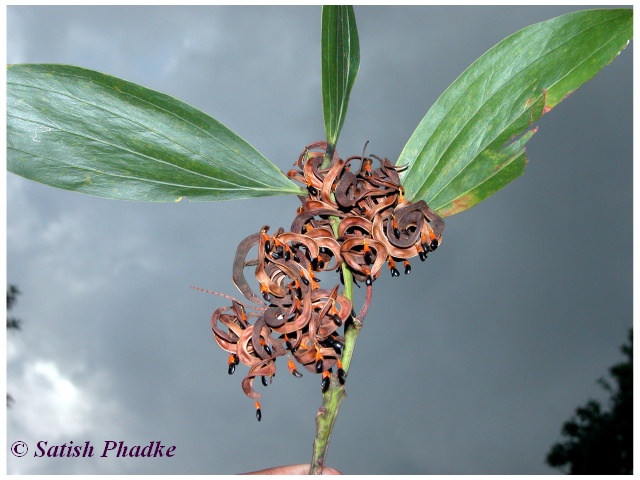 Fabaceae-Mimosoideae (Mimosaceae) Week: Acacia auriculiformis:
Fabaceae-Mimosoideae (Mimosaceae) Week: Acacia auriculiformis:
